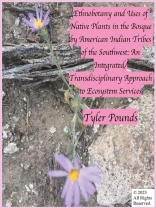All Rights Reserved
Copyright Registration Number / Date: TX0009300836 / 2023-07-27
Library of Congress Control Number: 2023911516
The First Book for Mr. Tyler Pounds ’Integrated Human-Nature Relations’. The ’School of Integrated Human-Nature Relations’ combines the fields of Anthropology, Wildlife Biology (Botany, Ecology, Zoology) into a cohesive integrated format. The school (and thus this book) delves into the direct links and relationships that humans have with nature. Exploring the direct links and relationships that humans have with nature is a critical first step on solving the worlds ’biodiversity crisis’. This book uses the fields of Ecological Anthropology, Ethnobotany, Integrated Biology to showcase biodiversity on Native American reservations as well as showcasing how Ethnographic Field Methods can be integrated and used for wildlife management through an ’Ecosystem Service’ lens. The showcasing of ecological data sets on Native American reservations is critical in proving to the world just how important and invaluable Traditional Ecological Knowledge (TEK) Systems are in conserving the worlds biodiversity. Integrating and ’bridging of the sciences’ will be crucial in solving the worlds biodiversity and global climate change crisis. We now stand in the ’Anthropocene Epoch’ of human caused ecological destruction. To value nature is to value one’s own self and well-being.
Innehållsförteckning
Table of Contents
Copyright Notice: v
Dedication(s): vi-vii
Forward and Acknowledgements: vii
Traditional Ecological Knowledge: 1-2
Applications of TEK through Methodological Practices: 2-3
Participatory Action-Based Research Approach: 3-4
Community-Based Service Learning: 4-5
The Importance of Plants in Tangible and Intangible Cultural Heritage, Heritage Resources, and Natural Resource Management: 6-8
TEK Forms, the BIOTEK Database Information Management System, the TRIBAL-RAD TEK System, and the GOV-RAD TEK System: 8-26
BIOTEK Database Information Management System Use in University/Researcher Settings: 26
Ecological Anthropology Becoming the Standard for Documenting ’Uses of Biodiversity’ (An Integrative Approach): 27-30
Solanum elaeagnifolium Cav. ’Silverleaf Nightshade’ (Ethnobotanical uses among the Navajo, Zuni, Cochiti-Pueblo, Isleta-Pueblo, Keresan-Pueblo, Hopi, Pima, Apache-White Mountain, and Spanish-American tribes): 31-39
Populus deltoides wislizenii ’Rio Grande Cottonwood’ (Ethnobotanical uses among the Acoma-Pueblo, Apache-Chiricahua and Mescalero, Apache-White Mountain, Isleta-Pueblo, Jemez-Pueblo, Keres Western-Pueblo, Laguna-Pueblo, Navajo, Pima, Tewa-Pueblo, and Zuni tribes): 40-51
Helianthus petiolaris ’Prairie Sunflower’ (Ethnobotanical uses among the Havasupai, Hopi, and Navajo tribes): 52-57
Chloracantha spinosa ’Mexican Devil-Weed’ (Ethnobotanical uses among the Mojave and Navajo tribes): 58-59
Anemopsis californica ’Yerba Mansa’ (Ethnobotanical uses among the Kamia- Kumeyaay, Keres Western-Pueblo, Paiute, Papago, and Pima tribes): 60-68
Prosopis pubescens ’Screwbean Mesquite’ (Ethnobotanical uses among the Apache-Chiricahua and Mescalero, Hualapai, Isleta-Pueblo, Kamia-Kumeyaay, Mojave, Paiute, Pima, Pima-Gila River, and Tewa-Pueblo tribes): 69-81
Cirsium neomexicanum ’New Mexico Thistle’ (Ethnobotanical uses among the Navajo, Navajo-Ramah, and Yavapai tribes): 82-85
Forestiera pubescens ’New Mexico Olive/Desert Olive/Stretchberry’ (Ethnobotanical uses among the Apache-Chiricahua and Mescalero, Hopi, Isleta- Pueblo, Jemez-Pueblo, Navajo, and Navajo-Ramah tribes): 86-91
Psorothamnus scoparius ’Broom Dalea’ (Ethnobotanical uses among the Keres Pueblo-Western tribe): 92-94
Vitis arizonica ’Arizona Grape/Canyon Grape’ (Ethnobotanical uses among the Apache-Chiricahua and Mescalero, Apache-Western (Western Apaches), Havasupai, Isleta-Pueblo, Jemez-Pueblo, and Navajo tribes): 95-100
Panicum capillare ’Witchgrass’ (Ethnobotanical uses among the Hopi, Keres Pueblo-Western, Navajo, Navajo-Ramah, and Tewa-Pueblo tribes): 101-104
Phragmites australis ’Common Reed’ (Ethnobotanical uses among the Apache- White Mountain, Cocopah, and Havasupai tribes): 105-108
Data Analysis of Documented Botanical Uses: 108-118
Integrating Bio-Cultural Diversity into Wildlife and Natural Heritage Conservation (Ecosystem Services): 119-123
Bio-Cultural Environmental Use Theory: 123-126
Human-Wildlife Resource Modeling (Predictive Modeling for Human-Wildlife Resource Use): 126-132
Special Thanks: 132-135
Afterword and Acknowledgements: 135-138
About the Author/Illustrator/Front & Back Cover Artist: 139-140
About the Editor: 141
Front and Back Cover Artwork (Photographs): 141-142
Sources Cited: 142-150
Om författaren
This book has additional editing work that has been completed by Dr. Todd Walborn (Psy.D). Dr. Walborn completed his doctorate in Psychology at Wright State University in Dayton, Ohio. Dr. Walborn (Psy.D) can be contacted at the email address:[email protected]












